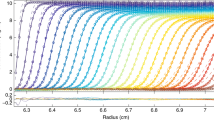Abstract
Silica colloidal crystals are a new type of media for protein electrophoresis, and they are assessed for their promise in rapidly measuring aggregation of monoclonal antibodies. The nature of silica colloidal crystals is described in the context of the need for a high-throughput separation tool for optimizing the formulations of protein drugs for minimal aggregation. The fundamental relations between molecular weight and mobility in electrophoresis are used to make a theoretical comparison of selectivity between gels and colloidal crystals. The results show that the selectivity is similar for these media, but slightly higher, 10%, for gels, and the velocity is inherently lower than that for gels due to the smaller free volume fraction. These factors are more than compensated for by lower broadening in colloidal crystals. These new media give plate heights of only 0.15 μm for the antibody monomer and 0.42 μm for the antibody dimer. The monoclonal antibody is separated from its dimer in 72 s over a distance of only 6.5 mm. This is five times faster than size-exclusion chromatography, with more than tenfold miniaturization, and amenable to parallel separations, all of which are promising for the design of high-throughput devices for optimizing protein drug formulations.







Similar content being viewed by others
References
An Z. Therapeutic monoclonal antibodies from bench to clinic. Hoboken: Wiley; 2009.
Dovichi NJ, Zhang JZ. How capillary electrophoresis sequenced the human genome. Angew Chem-Int Edit. 2000;39(24):4463–8.
Jorgenson JW, Lukacs KD. Zone electrophoresis in open-tubular glass-capillaries. Anal Chem. 1981;53(8):1298–302.
Gomis DBL, Junco S, Exposito Y, Gutierrez D. Size-based separations of proteins by capillary electrophoresis using linear polyacrylamide as a sieving medium: model studies and analysis of cider proteins. Electrophoresis. 2003;24(9):1391–6.
Guttman A, Nolan J. Comparison of the separation of proteins by sodium dodecyl-sulfate slab gel-electrophoresis and capillary sodium dodecyl-sulfate gel-electrophoresis. Anal Biochem. 1994;221(2):285–9.
Zhu ZF, Lu JJ, Liu SR. Protein separation by capillary gel electrophoresis: a review. Anal Chim Acta. 2012;709:21–31.
Colvin VL. From opals to optics: colloidal photonic crystals. MRS Bull. 2001;26(8):637–41.
Stober W, Fink A, Bohn E. Controlled growth of monodisperse silica spheres in micron size range. J Colloid Interface Sci. 1968;26(1):62–9.
Jiang P, Bertone JF, Hwang KS, Colvin VL. Single-crystal colloidal multilayers of controlled thickness. Chem Mat. 1999;11(8):2132–40.
Miguez H, Meseguer F, Lopez C, Mifsud A, Moya JS, Vazquez L. Evidence of FCC crystallization of SiO2 nanospheres. Langmuir. 1997;13(23):6009–11.
Pusey PN, Vanmegen W, Bartlett P, Ackerson BJ, Rarity JG, Underwood SM. Structure of crystals of hard colloidal spheres. Phys Rev Lett. 1989;63(25):2753–6.
Zeng Y, Harrison DJ. Self-assembled colloidal arrays as three-dimensional nanofluidic sieves for separation of biomolecules on microchips. Anal Chem. 2007;79(6):2289–95.
Zeng Y, He M, Harrison DJ. Microfluidic self-patterning of large-scale crystalline nanoarrays for high-throughput continuous DNA fractionation. Angew Chem-Int Edit. 2008;47(34):6388–91.
Birdsall RE, Koshel BM, Hua Y, Ratnayaka SN, Wirth MJ. Modeling of protein electrophoresis in silica colloidal crystals having brush layers of polyacrylamide. Electrophoresis. 2013. doi:10.1002/elps.201200413.
Jiang P, Prasad T, McFarland MJ, Colvin VL. Two-dimensional nonclose-packed colloidal crystals formed by spincoating. Appl Phys Lett. 2006;89(1).
Wei BC, Rogers BJ, Wirth MJ. Slip flow in colloidal crystals for ultraefficient chromatography. J Am Chem Soc. 2012;134(26):10780–2.
Kamp U, Kitaev V, von Freymann G, Ozin GA, Mabury SA. Colloidal crystal capillary columns—towards optical chromatography. Adv Mater. 2005;17(4):438–43.
Malkin DS, Wei BC, Fogiel AJ, Staats SL, Wirth MJ. Submicrometer plate heights for capillaries packed with silica colloidal crystals. Anal Chem. 2010;82(6):2175–7.
Moon JH, Kim S, Yi GR, Lee YH, Yang SM. Fabrication of ordered macroporous cylinders by colloidal templating in microcapillaries. Langmuir. 2004;20(5):2033–5.
Wei B, Malkin DS, Wirth MJ. Plate heights below 50 nm for protein electrochromatography using silica colloidal crystals. Anal Chem. 2010;82(24):10216–21.
Egas DA, Wirth MJ. Fundamentals of protein separations: 50 years of nanotechnology, and growing. Annu Rev Anal Chem. 2008;1:833–55.
Pal S, Fauchet PM, Miller BL. 1-D and 2-D photonic crystals as optical methods for amplifying biomolecular recognition. Anal Chem. 2012;84(21):8900–8.
Huang X, Wirth M. Surface-initiated radical polymerization on porous silica. Anal Chem. 1997;69:4577–80.
Papautsky I, Mohanty S, Weiss R, Frazier AB. High lane density slab-gel electrophoresis using micromachined instrumentation. Electrophoresis. 2001;22(18):3908–15.
Kopecka K, Drounin G, Slater G. Capillary electrophoresis sequencing of small ssDNA molecules versus Ogston regime: fitting data and interpreting parameters. Electrophoresis. 2004;25:2177–85.
Mahler HC, Friess W, Grauschopf U, Kiese S. Protein aggregation: pathways, induction factors and analysis. J Pharm Sci. 2009;98(9):2909–34.
Slavickova A. Electrophoresis of nonreduced IgM and IgG monoclonal-antibodies on mixed agarose-polyacrylamide gels. Electrophoresis. 1990;11(10):892.
Acknowledgments
This work was supported by Eli Lilly, Inc. (NNJ) and by NIH under grant R21CA161772 (REB).
Author information
Authors and Affiliations
Corresponding author
Additional information
Guest Editor: Craig Svensson
Rights and permissions
About this article
Cite this article
Njoya, N.K., Birdsall, R.E. & Wirth, M.J. Silica Colloidal Crystals as Emerging Materials for High-Throughput Protein Electrophoresis. AAPS J 15, 962–969 (2013). https://doi.org/10.1208/s12248-013-9506-2
Received:
Accepted:
Published:
Issue Date:
DOI: https://doi.org/10.1208/s12248-013-9506-2




